Program
I  Program
II
Program
II  Program
III
Program
III  Program
IV
Program
IV  Program
V
Program
V  Program
VI
Program
VI
Program
III: Almost SOLO:
Wednesday, March 26, 2003, ProArte
Institute, St. Petersburg
Tippeke
18min, 2000
Director:
Thierry
De Mey; Choreographer:
Anne
Teresa De Keersmaeker
Distributor: ROSAS, C-Sales
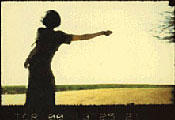
photos:
T. De Mey |
|
Wandering
through the woods and running across changing landscapes, Anne
Teresa De Keersmaeker narrates an old Flemish children's song
about "Tippeke", a little boy who refuses to go home,
unless his mother carries him. Tippeke
was part of Rosas' 1996 production "Woud".
The choreography and dance are inspired by the work of the German
Valeska Gert.
Born
in 1956, Thierry De Mey,
a film director, composer and percussionist has collaborated
with such renowned choreographers as Anne Teresa De Keersmaeker,
Wim Vandekeybus, Michèle-Anne De Mey and others. He is
also a founder of the group Maximalist!, a creative laboratory
for the young composers.
Anne
Teresa De Keersmaeker, one of the most prominent
modern European choreographers studied at MUDRA in Brussels,
the school linked to La Monnaie and to Maurice Béjart's
Ballet of the XXth Century, and then at the Tisch School of
the Arts in New York. On her return from the States, she founded
her company Rosas and created Rosas danst Rosas – the creation
that brought Rosas an international recognition. Together with
Rosas and Brussels' Royal Opera De Munt/La Monnaie, Anne Teresa
De Keersmaeker has launched a new international school for contemporary
dance, where sixty students coming from some 25 countries are
trained, over a three-year period, by more than 50 teachers.
http://www.rosas.be/
Little
Lieutenant 7min, 1994 (USA)
Director: Henry Hills, Chorographer/Dancer:
Sally Silvers
Distributor: Canyon Cinema
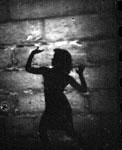 photo:
H. Hills
photo:
H. Hills |
Little
Lieutenant is a look back at the late Weimar era
with its struggles and celebrations leading up to world war,
a period piece. Scored to John Zorn's arrangement of the Kurt
Weill song, "Little Lieutenant of the Loving God",
and drawing its imagery both from the original song and its
somewhat idiosyncratic rearrangement, the film presents an internal
reading of Silver’s solo scored to the same musical piece,
"Along the Skid Mark of Recorded History".
Born
in Atlanta, Georgia (USA), Henry Hills
has made 22 short experimental films since 1975 which have been
shown in numerous festivals around the world. Since 1990 he
has worked as an editor and director for many film productions
and music videos including LOOKING FOR RICHARD by Al Pacino
(winner of the 1995 A.C.E. Award for Best Editing of a Documentary).
http://www.henryhills.com
Minou
6min, 2002 (UK)
Choreographer/Director: Magali Charrier
Distributor:
South East Dance Agency
 photo:
M. Charrier
photo:
M. Charrier |
Winner
of Best Screen Choreography Award 2002 at the Dance Screen Festival
in Monte Carlo, Minou tells
a story of a young woman who, despite her solitary life, has her
romantic aspirations and quirky relationships with the objects
in her apartment.
Motion
Control 2002, 8min (UK)
Director: David Anderson;
Choreographer: Liz Aggiss / Billy Cowie
Distributor:
South East Dance Agency
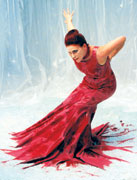 photo:
D. Anderson
photo:
D. Anderson |
Take
one glamorous and aging dancer. Trap her in the real world then
smash into her private reality. Control her movement, contain
her emotion. Well you can try but she has already beaten you
to it. With hyper-sound and super-smart awareness submit to
this bizarre journey of entrapment.
Motion Control has won the Czech Crystal at the Prague
Golden film Festival 2002 and received the Paula Citron Award
at the Moving Pictures Festival in Toronto 2002 for “the
seamless and fearless creation of a duet for the camera and
performer”.
David
Anderson’s work has encompassed theatre, dance
animation and live action. David’s films have won numerous
awards including a British Academy Award, the Hiroshima Peace
Prize as well as San Francisco Golden Gate Award. His previous
films include Deadsey and Door and are part of the collections
of the Metropolitan Museum New York, the British Film Institute
and Australian Museum of Moving Image.
Liz
Aggiss and Billy Cowie
have been artistic collaborators making dance for camera and
live performance for many years. Numerous film Awards include
BBC Dance for Camera, Meridian Taped Up, and Capture 2 Award.
Liz Aggiss has recently been appointed as a Professor of Visual
Performance at the University of Brighton.
Cornered
3min, 2001(Canada)
Director: Michael Downing;
Choreographer/Dancer: Susanna Hood
Distributor:
Michael
Downing
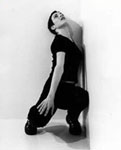 photo:
M. Downing
photo:
M. Downing |
Cornered
is a four-minute black and white film featuring a dancer in
a corner. The choreography of both the performer and the camera,
create a vertiginous attraction of right angles in this post-modern
adaptation of the classic Fred Astaire dance sequence in the
film "The Royal Wedding" when Fred Astaire is dancing
on the walls and ceiling. Some sections of the film are optically
printed in reverse, manipulating the forward and reverse movement
of the dancer. This effect is also created in the music which
combines a Maria Callas recording on vinyl being scratched,
looped and mixed by a DJ. – Dance Screen 1999.
Born in
San Francisco, Michael Downing
performed with the National Ballet of Canada and later on established
himself as an independent choreographer. At the same time, he
attended the American Film Institute in Los Angeles and produced
a number of commercials. Recently he has been focusing on creating
short films that include dance as a social element. These shorts
have been screened at the the festivals around the world including
Toronto International Film Festival and Clermont International
Short Film Festival.
Susanna
Hood’s work explores the integration of voice
and movement and the melding of artistic disciplines. With Toronto
Dance Theatre from 1991-1995, she now works as an independent
dancer and choreographer in Toronto, collaborating with such
artists as Michael Downing, Joey Meyer and Gerry Trentham, among
others.
Ghostcatching
7min, 1999 (US)
Directors / Choreographers: Paul Kaiser,
Shelley Eshkar, and Bill T. Jones
Distributor:
Paul
Kaiser
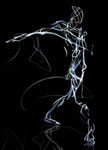 photo:
RS. Eshkar
photo:
RS. Eshkar |
Ghostcatching
finds its place in the unexpected intersection of dance, drawing,
and computer composition. The work is made possible by advances
in motion capture, a technology that tracks sensors attached
to a moving body… Here, the body of Bill T. Jones is multiplied
into many dancers, who perform as three-dimensional drawings.
Their anatomies are intertwinings of drawn strokes, which are
in fact painstakingly modeled as geometry on the computer --
never drawn on paper. So, we may ask: What is human movement
in the absence of the body? Can the drawn line carry the rhythm,
weight, and intent of physical movement? What kind of dance
do we conceive in this ghostly place, where enclosures, entanglements,
and reflections vie with the will to break free? –
Paul Kaiser, Shelley Eshkar, Bill T. Jones
Paul
Kaiser is a New York-based digital artist whose work
has been exhibited at many venues around the world. He has received
numerous awards, including a Guggenheim Fellowship in 1996 and
the Congress of Research in Dance in 2000. Kaiser's early art
(1975-81) was in experimental filmmaking and voice audiotapes.
He then spent ten years teaching students with severe learning
disabilities, with whom he collaborated on making multimedia
depictions of their own minds. He later applied this approach
to an interactive documentary on Robert Wilson's early work
entitled Visionary of Theater (1994-97). Kaiser has collaborated
on the virtual dances with Merce Cunningham, Shelley Eshkar,
Bill T. Jones and Marc Downie. http://www.kaiserworks.com/
Bill
T. Jones is the artistic director of the Bill T.
Jones/Arnie Zane Dance Company, and one of the greatest living
solo dancers. He has received many honors and awards, including
a MacArthur "Genius" award in 1994. http://www.billtjones.org/
Hyperalarm
Dance 3 min 2002 (US)
Director / Choreographer: Michael Cole
Distributor:
Michael
Cole
 photo:
M.Cole
photo:
M.Cole |
Hyperalarm
Dance
is a 4-minute computer animated modern dance music video. The
movement material for the work was originally performed onstage
and was later re-conceptualized and transformed into a dream
sequence that takes place inside the workings of a digital alarm
clock. "Hyper Alarm Dance" utilizes motion-capture
techniques to bring the movement data into the computer. The
resulting motion is just as sharp, precise and fluid as that
in the stage version but is re-presented in a colorful and dynamic
environment that could only be created through computer graphics.
Michael
Cole makes computer-animated dances by means of his
own body, a series of infra-red cameras and 3-D animation software.
For nine years he toured the globe with the Merce Cunningham
Dance Company. After this point, he has worked on his choreographic
skills at Arizona State University and on his animation skills
at the Academy of Art College in San Francisco. He earned masters
degrees from both institutions and currently lives both in New
York and San Francisco.
Program
I  Program
II
Program
II  Program
III
Program
III  Program
IV
Program
IV  Program
V
Program
V  Program
VI
Program
VI
© Kinodance–Russia, 2004
akovgan@kinodance.com

